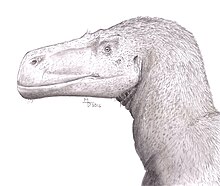Wiehenvenator
This article has been registered in the quality assurance biology for improvement due to formal or content-related deficiencies . This is done in order to bring the quality of the biology articles to an acceptable level. Please help improve this article! Articles that are not significantly improved can be deleted if necessary.
Read the more detailed information in the minimum requirements for biology articles .
| Wiehenvenator | ||||||||||
|---|---|---|---|---|---|---|---|---|---|---|

Hypothetical living reconstruction of Wiehenvenator |
||||||||||
| Temporal occurrence | ||||||||||
| Middle Jurassic (Middle Callovian ) | ||||||||||
| Locations | ||||||||||
| Systematics | ||||||||||
|
||||||||||
| Scientific name | ||||||||||
| Wiehenvenator | ||||||||||
| Rauhut , Hübner & Lanser , 2016 | ||||||||||
| Art | ||||||||||
|
||||||||||
Wiehenvenator is a genus of theropod dinosaurs from the group of Megalosauridae from the Middle Jura of Germany . The only known species is Wiehenvenator albati .
Discovery and naming
The fossil remains of the only previously known specimen were found in 1998 in the disused Pott sand-lime quarry north of the Lutternschen Egge summit , 256 m above sea level. NHN high mountain in the Wiehengebirge , found in the Haddenhausen district of the East Westphalian city of Minden . The geologist Friedrich Albat discovered this during a routine inspection on behalf of the LWL Museum für Naturkunde . The finds come from the Ornatenton formation in the North German Dogger group and are dated to the middle Callovian .
The dinosaur became known to the public in November 1999 through an article in National Geographic Germany magazine as the Monster of Minden . The find generated wide press coverage. As a result, the theropod first came to be known by the name used by the magazine.
In 2015, Oliver Rauhut , Tom Hübner and Klaus-Peter Lanser published that the find was a previously unknown species of megalosaurid. In the following year they provided the first description of the genus Wiehenvenator and the species Wiehenvenator albati . The authors honor the discoverer of the fossils with the species name .
description
The fossils include an upper jaw , an intermaxillary bone , two caudal vertebrae , a tooth, rib fragments and a complete rib.
According to the National Geographic article, a complete rib is one and a half times the size of an Allosaurus , and the tooth with the root is said to be about 30 centimeters long. This led to the initial assumption that the animal was about 15 meters long, making it the largest theropod found in Europe to date.
According to Mickey Mortimer, the complete skull was about one meter long, but the total length of the individual is seven to eight meters. According to Rauhut et al. the known specimen was most likely a large, not fully grown animal with a length of eight to nine meters, based on comparisons with the closely related Torvosaurus . This makes it the largest theropod discovered in Central Europe to date .
Others
The prepared finds are now accessible to the public in the LWL Museum für Naturkunde in Münster . As part of the permanent exhibition "Dinosaurs - The prehistoric times are alive!", A reconstruction of the find situation and a life-size static model are presented in addition to the original remains.
Individual evidence
- ↑ Three German dinosaurs . In: National Geographic Germany . November 1999, ISSN 1615-0872 ( Scanned section of the illustrations by Harro Maass on harromaass.com [accessed June 11, 2020]).
- ↑ The Monster of Minden. In: Spiegel Online . DER SPIEGEL GmbH & Co. KG, September 1, 2016, accessed on June 11, 2020 .
- ↑ Daniela Mocker: What is the "Monster of Minden"? In: Spectrum of Science . Spectrum der Wissenschaft Verlagsgesellschaft mbH, September 2, 2016, accessed on June 11, 2020 .
- ^ Rauhut et al .: A new theropod dinosaur from the late Middle Jurassic of Germany and theropod faunal turnover during the Jurassic. Libro de resúmenes del V Congreso Latinoamericano de Paleontología de Vertebrados. 62, 2015.
- ↑ Oliver WM Rauhut, Tom R. Hübner, Klaus-Peter Lanser: A new megalosaurid theropod dinosaur from the late Middle Jurassic (Callovian) of north-western Germany: Implications for theropod evolution and faunal turnover in the Jurassic. Palaeontologia Electronica February 19, 29A: 1-65, 2016 palaeo-electronica.org/content/2016/1536-german-jurassic-megalosaurid.
- ↑ Mike Taylor: What were the longest / heaviest predatory dinosaurs? , December 15, 2003
- ^ Predatory dinosaur - the first of its kind. In: LWL-Newsroom. Landschaftsverband Westfalen-Lippe , September 1, 2016, accessed on June 9, 2020 .
- ↑ Largest predatory dinosaur in Germany revealed. In: LWL Newsroom. Landschaftsverband Westfalen-Lippe, February 5, 2020, accessed on June 9, 2020 .
Web links
- Mindener Tageblatt: The monster has a name print edition from September 2, 2016, and more.
